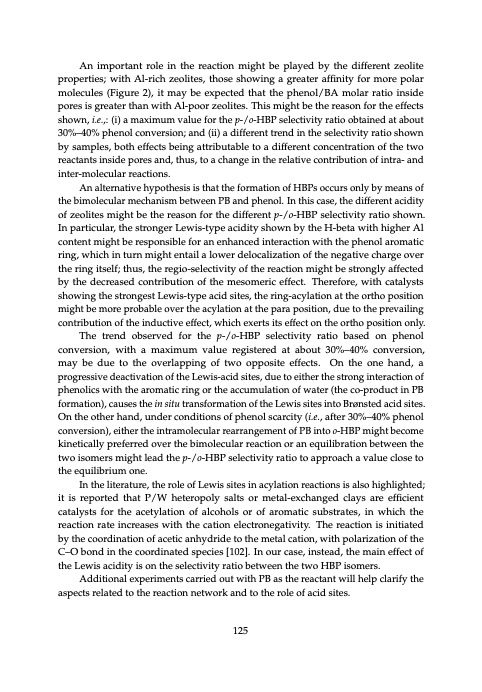
PDF Publication Title:
Text from PDF Page: 140
An important role in the reaction might be played by the different zeolite properties; with Al-rich zeolites, those showing a greater affinity for more polar molecules (Figure 2), it may be expected that the phenol/BA molar ratio inside pores is greater than with Al-poor zeolites. This might be the reason for the effects shown, i.e.,: (i) a maximum value for the p-/o-HBP selectivity ratio obtained at about 30%–40% phenol conversion; and (ii) a different trend in the selectivity ratio shown by samples, both effects being attributable to a different concentration of the two reactants inside pores and, thus, to a change in the relative contribution of intra- and inter-molecular reactions. An alternative hypothesis is that the formation of HBPs occurs only by means of the bimolecular mechanism between PB and phenol. In this case, the different acidity of zeolites might be the reason for the different p-/o-HBP selectivity ratio shown. In particular, the stronger Lewis-type acidity shown by the H-beta with higher Al content might be responsible for an enhanced interaction with the phenol aromatic ring, which in turn might entail a lower delocalization of the negative charge over the ring itself; thus, the regio-selectivity of the reaction might be strongly affected by the decreased contribution of the mesomeric effect. Therefore, with catalysts showing the strongest Lewis-type acid sites, the ring-acylation at the ortho position might be more probable over the acylation at the para position, due to the prevailing contribution of the inductive effect, which exerts its effect on the ortho position only. The trend observed for the p-/o-HBP selectivity ratio based on phenol conversion, with a maximum value registered at about 30%–40% conversion, may be due to the overlapping of two opposite effects. On the one hand, a progressive deactivation of the Lewis-acid sites, due to either the strong interaction of phenolics with the aromatic ring or the accumulation of water (the co-product in PB formation), causes the in situ transformation of the Lewis sites into Brønsted acid sites. On the other hand, under conditions of phenol scarcity (i.e., after 30%–40% phenol conversion), either the intramolecular rearrangement of PB into o-HBP might become kinetically preferred over the bimolecular reaction or an equilibration between the two isomers might lead the p-/o-HBP selectivity ratio to approach a value close to the equilibrium one. In the literature, the role of Lewis sites in acylation reactions is also highlighted; it is reported that P/W heteropoly salts or metal-exchanged clays are efficient catalysts for the acetylation of alcohols or of aromatic substrates, in which the reaction rate increases with the cation electronegativity. The reaction is initiated by the coordination of acetic anhydride to the metal cation, with polarization of the C–O bond in the coordinated species [102]. In our case, instead, the main effect of the Lewis acidity is on the selectivity ratio between the two HBP isomers. Additional experiments carried out with PB as the reactant will help clarify the aspects related to the reaction network and to the role of acid sites. 125PDF Image | Zeolite Catalysis

PDF Search Title:
Zeolite CatalysisOriginal File Name Searched:
Zeolite_Catalysis.pdfDIY PDF Search: Google It | Yahoo | Bing
NFT (Non Fungible Token): Buy our tech, design, development or system NFT and become part of our tech NFT network... More Info
IT XR Project Redstone NFT Available for Sale: NFT for high tech turbine design with one part 3D printed counter-rotating energy turbine. Be part of the future with this NFT. Can be bought and sold but only one design NFT exists. Royalties go to the developer (Infinity) to keep enhancing design and applications... More Info
Infinity Turbine IT XR Project Redstone Design: NFT for sale... NFT for high tech turbine design with one part 3D printed counter-rotating energy turbine. Includes all rights to this turbine design, including license for Fluid Handling Block I and II for the turbine assembly and housing. The NFT includes the blueprints (cad/cam), revenue streams, and all future development of the IT XR Project Redstone... More Info
Infinity Turbine ROT Radial Outflow Turbine 24 Design and Worldwide Rights: NFT for sale... NFT for the ROT 24 energy turbine. Be part of the future with this NFT. This design can be bought and sold but only one design NFT exists. You may manufacture the unit, or get the revenues from its sale from Infinity Turbine. Royalties go to the developer (Infinity) to keep enhancing design and applications... More Info
Infinity Supercritical CO2 10 Liter Extractor Design and Worldwide Rights: The Infinity Supercritical 10L CO2 extractor is for botanical oil extraction, which is rich in terpenes and can produce shelf ready full spectrum oil. With over 5 years of development, this industry leader mature extractor machine has been sold since 2015 and is part of many profitable businesses. The process can also be used for electrowinning, e-waste recycling, and lithium battery recycling, gold mining electronic wastes, precious metals. CO2 can also be used in a reverse fuel cell with nafion to make a gas-to-liquids fuel, such as methanol, ethanol and butanol or ethylene. Supercritical CO2 has also been used for treating nafion to make it more effective catalyst. This NFT is for the purchase of worldwide rights which includes the design. More Info
NFT (Non Fungible Token): Buy our tech, design, development or system NFT and become part of our tech NFT network... More Info
Infinity Turbine Products: Special for this month, any plans are $10,000 for complete Cad/Cam blueprints. License is for one build. Try before you buy a production license. May pay by Bitcoin or other Crypto. Products Page... More Info
| CONTACT TEL: 608-238-6001 Email: greg@infinityturbine.com | RSS | AMP |